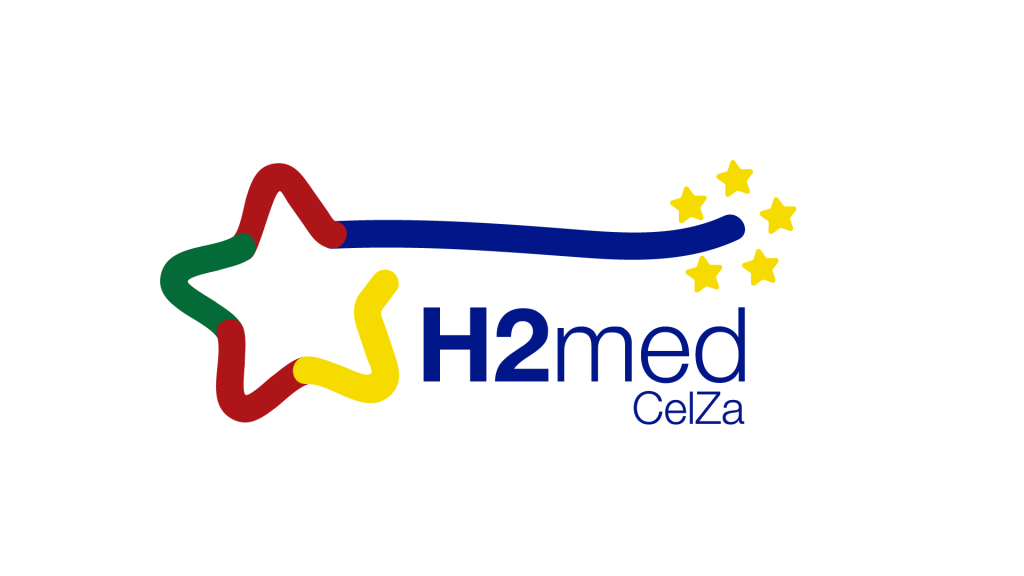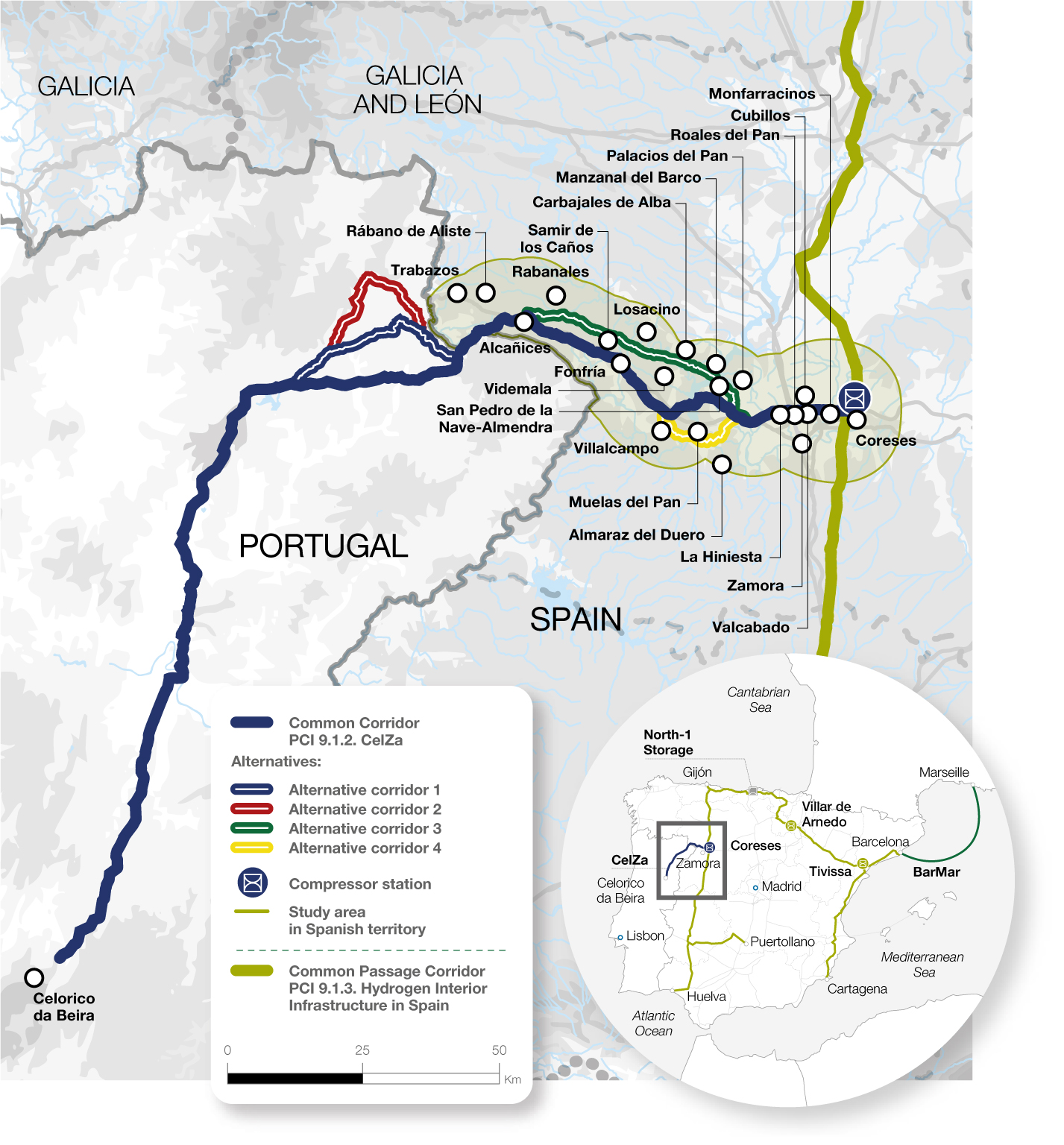
A strategic hydrogen
connection for Europe
PCI 9.1.2. Portugal-Spain Hydrogen Interconnector



The project
The CelZa project (PCI 9.1.2.) is the green hydrogen interconnection line between Portugal and Spain. This project will link the towns of Celorico da Beira, in Portugal, and Coreses, in Zamora, through an underground pipeline. Together with BarMar, which is the green hydrogen interconnection line between Spain and France (PCI 9.1.4.), CelZa is part of the H2med project, the first renewable hydrogen corridor in the European Union, which will connect hydrogen production on the Iberian Peninsula with consumption centres in north-western Europe.
CelZa is the network in charge of connecting and communicating the Portuguese internal green hydrogen infrastructure (PCI 9.1.1.) with the Spanish internal green hydrogen infrastructure (PCI 9.1.3.). The operators assigned for the development of the projects in each region are: REN for the Portuguese sections, and Enagás for the Spanish sections.
In addition, the CelZa project envisages a 30 MW compressor station in Coreses (Zamora), which will be the connection point between the two internal infrastructures of each country.

An essential project for Europe
The Iberian Peninsula is in an excellent position to become the first green hydrogen hub in the European Union thanks to its large capacity for renewable energy generation, excellent geographical position, industrial technological capacity, powerful network of infrastructures and broad experience in network management.
CelZa will be the main export channel from Portugal, and connection with Spain, for this energy vector produced from renewable energy sources such as solar and wind energy. Together with BarMar, H2med will enable the export of up to 2 million tonnes of renewable hydrogen to central Europe, starting in the early 2030s.
The development of this green hydrogen energy infrastructure will help to drive the decarbonisation of European industry and achieve the goals of the European Green Pact and REPowerEU.
270
KM in TOTAL
86
KM in SPAIN
1
COMPRESSOR STATION
0,75
MILLION TONNES PER YEAR (MAXIMUM CAPACITY)
7,2M€
IN CEF FUNDING
EU-funded project
On 30 January 2025, the European Commission granted 100% of the Connecting Europe Facility (CEF) Energy funds requested by Enagás for the CelZa interconnection, a grant amounting to 7,221,872 euros, to conduct the basic and detailed engineering phases for the infrastructure on the Spanish side and the associated compressor station located in Coreses (Zamora).
View the EU Transparency Platform here.

An opportunity for Spain and Portugal

Growth and competitiveness
≈350 M€ in investment

A more sustainable energy future
A hydrogen network is key to decarbonising industry and heavy transport

Technological and industrial development
Creation of a hydrogen industry and generation of an innovative business fabric

Regional job creation and revitalisation
1,700 new jobs during the construction of the H2med (CelZa y BarMar) network and storage facilities and 300 in operation and maintenance
Where and how will the hydrogen transported along this section be produced?
The hydrogen transported through this pipeline, of Portuguese origin, will be generated by the electrolysisof water, using all the electricity needed from 100% renewable sources, such as the sun and wind. This is why this hydrogen is considered “green” (renewable), as no greenhouse gases are emitted during its production.
What role will this interconnection line play in the European context?
The H2med project and its CelZa interconnection line will be of fundamental strategic importance in the European hydrogen context. H2med will be able to transport up to 2 million tonnes of renewable hydrogen per year, representing 10% of Europe’s projected consumption by 2030 according to the REPowerEU plan. This makes it a key piece in Europe’s new energy horizon.
The CelZa (Celorico da Beira-Zamora) interconnection line will connect Portugal and Spain with a capacity of 0.75 million tonnes per year. It is a hydro-pipeline approximately 270 km long intended exclusively for the transport of green hydrogen. The project is particularly relevant in the framework of the REPowerEU plan, which strives to attain European energy independence.
What specific infrastructure is planned for the section between Spain and Portugal?
The CelZa connection, part of the H2Med hydrogen corridor between Portugal and Spain, will be composed of several key infrastructures.
Firstly, there is a hydrogen pipeline consisting of underground pipelines and above-ground valve positions that act as auxiliary facilities. A compressor station is also envisaged, located in the town of Coreses, as an extension of the existing compressor station, equipped with compressors driven by electric motors and high-voltage lines for its energy supply.
This network will be integrated with other strategic infrastructures: the internal hydrogen network in Portugal (PCI Project 9.1.1), the internal hydrogen network in Spain (PCI Project 9.1.3) and the interconnection line between Spain and France (PCI Project 9.1.4), known as H2Med-BarMar, which will be conducted via a underwater pipeline between Barcelona and Marseilles.
In addition, there are two underground hydrogen storage projects in Spain: Hydrogen Storage North-1 (PCI 9.24.1) and Hydrogen Storage North-2 (PCI 9.24.2), which complement the operational capability of this transnational network.
What is the project’s planned timetable and what stage of development is it at?
During the second quarter of 2025, Enagás awarded the engineering works and environmental studies, and between 2025 and 2026 the basic and detailed engineering of the project, environmental studies and other permits will be implemented.
Construction work on the pipeline is scheduled to begin in late 2027-2028, with completion expected in the early 2030s. In parallel, the documentation and deployment process of the Public Participation Concept Plan (PCPP) of this interconnection is being implemented. This is a requirement established in the European regulation for the so-called Projects of Common Interest (PCI), with the objective of identifying from an early stage the sensitivities and concerns about the project in the region where the infrastructure would be implemented.
The deployment of this public participation process will take place from November 2025 and is expected to be completed in December of the same year.
What impact does it have on the local economy and job creation in the regions concerned?
The impetus of green hydrogen can contribute to reindustrialisation, foster innovation, and draw socially responsible investment. The hydrogen infrastructure network in Spain, together with its international connections, will act as a driving force for multiple sectors of the national economy, generating new business opportunities.
This deployment will have a positive economic impact on the country and its regions, boosting their growth and competitiveness. A gross investment of 3.31 billion euros is foreseen until 2030,approximately 350 million euros of which will go to the CelZa project.
In addition, it will contribute to industrial and technological development by creating a hydrogen industry and an innovative business fabric. During the construction phase of the network, an estimated 17,200 jobs will be created, and around 900 jobs will be maintained in the operation and maintenance phases.
In the specific case of H2Med (CelZa and BarMar), some 1,700 jobs are expected to be generated during construction and 300 during operation and maintenance.
Data source: “Socio-economic impact of the development of the hydrogen economy in Spain”, a report issued by PwC for Enagás in 2023.
What will be the consequences in terms of environmental impact?
Environmental protection is a top priority at all stages of the project. After an exhaustive identification and assessment of the possible environmental impacts that the project may have on the affected areas, it has been assessed that the project will have a minimal environmental impact, since the final installation of the pipeline is underground, with no visual or environmental impact, and once its construction is completed, the affected land will be fully restored to its exact previous situation, with immediate recovery. In parallel, different preventive and corrective measures have been defined to minimise the consequences during the different phases of construction and implementation of the project.
Public participation
The development of the CelZa interconnection line, as a PCI project and in adherence with EU guidelines, requires the development of a Public Participation Concept Plan (PPCP), with the goal of explaining the fundamental characteristics of the project to all stakeholders and involving them in decision-making from the outset and on an ongoing basis.
In Spain, Enagás began the formal processing of securing the applicable authorisations for this project in accordance with Regulation (EU) 2022/869 and the Manual of the Procedure for the Authorisation of Energy PCIs in Spain, published by the Ministry for Ecological Transition and the Demographic Challenge (MITECO) in October 2023.
In compliance with the provisions of the TEN-E Regulation of the European Union (EU Regulation 2022/869), the project developer in each region is obliged to implement a public participation plan to inform and involve citizens and stakeholders in decision-making on a Project of Common Interest (PCI) in the field of energy.
The process begins on 17 November and will end on 15 December 2025.
What are the objectives?
- Transparent reporting: share clear information on this hydrogen interconnection line with all stakeholders.
- Answering questions and explaining the need for and benefits of the project.
- Involving the community: encourage their active participation in the process.
- Identifying and mitigating impacts: in advance and ensuring the most appropriate initiatives to address them.
- Improving the project’s acceptance: taking into account environmental sensitivity and social legitimacy from an early stage.
What does it consist of?
These are some of the main informative and participative initiatives that Enagás will be carrying out in this process:

Website

Information leaflet
View it here.

Participatory meetings with citizens and the administration

Dissemination through information points (fixed and mobile)

Seminars with experts
Acknowledgement of receipt of project notification to MITECO
13/11/2025
CelZa
Conceptual Plan for Public Participation
13/11/2025
CelZa
MITECO approval document for the PCPP
13/11/2025
CelZa
PCI Portugal-Spain Interconnector File
13/11/2025
CelZa
PCI Procedure Manual Annex
13/11/2025
CelZa

Communication
Keep up to date with all the news about the project and its public participation process.
Contact
Published on 13/11/2025
Last updated on 20/11/2025

